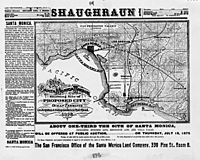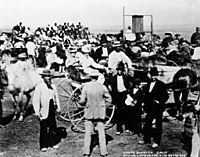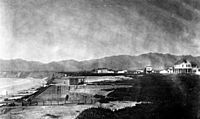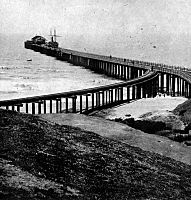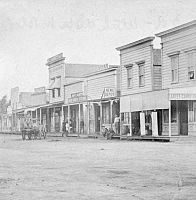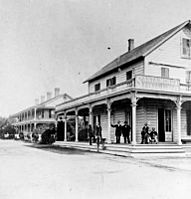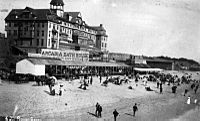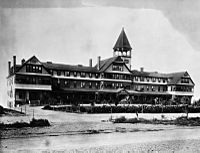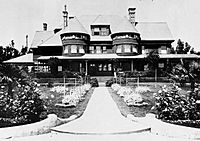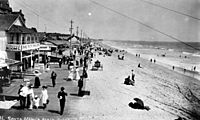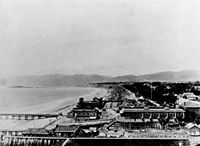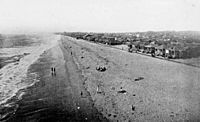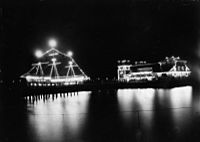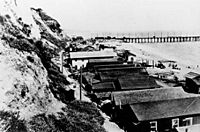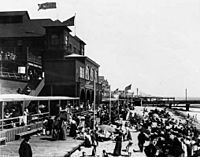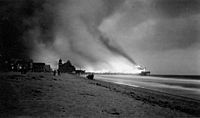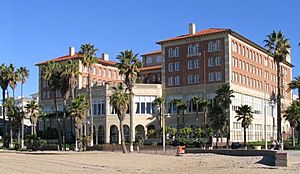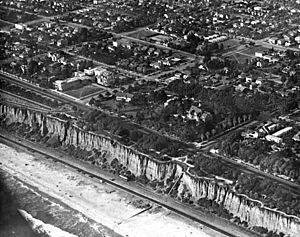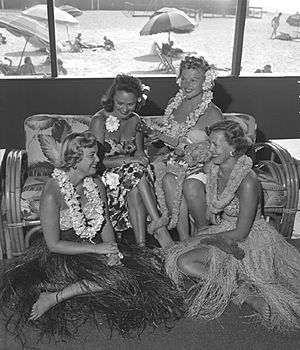History of Santa Monica, California facts for kids
Santa Monica, California, is a famous city right by the Pacific Ocean. It has a long and interesting history, full of big changes and important moments. Let's explore how this sunny beach town became what it is today!
Contents
- Early Days: Native Americans and Explorers
- Building a New Town in the 1870s
- Growth and Hotels in the 1880s
- The Port Dream and Ocean Park in the 1890s
- Amusement Piers and New Beginnings in the 1900s
- Racing and Changes in the 1910s
- The Roaring Twenties and Aviation History
- The Great Depression and World War II (1930s-1940s)
- Post-War Era: 1950s and 1960s
- Health, Fitness, and Community in the 1970s
- Revitalization and Challenges in the 1980s
- New Developments and Environmental Concerns in the 1990s
- The 2000s and Beyond
- Images for kids
Early Days: Native Americans and Explorers
Santa Monica was first home to the Tongva people for many years. They had a village called Comicranga in the area. A famous resident was Victoria Reid, whose father was the village chief. The Tongva people called this general area Kecheek.
In 1769, a group of Spanish explorers led by Gaspar de Portolà arrived. They camped near what is now Barrington and Ohio Avenues. There are two stories about how Santa Monica got its name. One says it was named after Saint Monica, but her feast day is in May, not August when they arrived. The other story says explorer Juan Crespí named it after springs that reminded him of the tears Saint Monica shed for her son. These springs, called Kuruvungna Springs, are very special to the Tongva people.
Crespí actually named the spot San Gregorio, but people started calling the springs "Santa Monica" by the early 1800s. The name Santa Monica was officially used in 1827 for a grazing permit.
Building a New Town in the 1870s
After California became part of the United States in 1848, the land that is now Santa Monica was sold. In 1872, Colonel Robert Symington Baker and his wife, Arcadia Bandini, bought a large piece of land. Arcadia was from a wealthy early California family. Later, Nevada Senator John Percival Jones bought half of Baker's land.
In 1875, Jones and Baker decided to create the town of Santa Monica. They sold the first lots on July 15, 1875. The town was built facing the ocean, with streets named after western states and numbers.
Senator Jones also built the Los Angeles and Independence Railroad to connect Santa Monica with Los Angeles. He also built a wharf (a long dock) into the bay. Santa Monica's oldest building is a brick building from 1873, which was once the town hall and is now part of a hostel.
The southern part of Santa Monica was once part of another large ranch. Some of this land was sold and later divided into smaller parcels for homes.
- Santa Monica in the 1870s
Growth and Hotels in the 1880s
Santa Monica's main business area started around what is now the Third Street Promenade. Early street names like Utah and Oregon were later changed to Broadway and Santa Monica Boulevard.
The town's first hotel, the Santa Monica Hotel, opened in 1885 but burned down in 1887. A grander hotel, the 125-room "Arcadia Hotel", opened in 1887. It was named after Arcadia Bandini and was one of the most famous hotels on the Pacific Coast.
On November 30, 1886, residents voted to officially become a city and chose their first city leaders. The original city limits were Montana Avenue to the north, 26th Street to the east, Colorado Avenue to the south, and the Pacific Ocean to the west.
Senator Jones built a large house called Miramar. His wife, Georgina, planted a Moreton Bay Fig tree in their front yard in 1889. This tree is still there today at the Fairmont Miramar Hotel and is the second-largest of its kind in California.
- Santa Monica in the 1880s
The Port Dream and Ocean Park in the 1890s
When the Southern Pacific Railroad reached Los Angeles, there was a big debate about where to build a major seaport. Some wanted Santa Monica, others preferred San Pedro Bay. In 1893, the Long Wharf was built in Santa Monica to handle large ships. It was called Port Los Angeles and was the longest pier in the world at 4700 feet, even having a train track on it!
However, the United States Congress chose San Pedro Bay (now the Port of Los Angeles) as the main port in 1897. This was disappointing for Santa Monica, but it helped the city keep its beautiful beachside charm. The old rail line was later used by the Pacific Electric Railway until 1933.
Meanwhile, Abbot Kinney bought land along the coast and named the area Ocean Park in 1895. He built an amusement park and homes there. After disagreements with his partners, he focused on the southern part of the property, which he developed into Venice of America.
- Santa Monica in the 1890s
Amusement Piers and New Beginnings in the 1900s
Amusement piers became very popular in the early 1900s. The Pacific Electric Railroad made it easy for people from all over Los Angeles to visit the beaches. Pier owners built bigger and bigger roller coasters. Wooden piers often caught fire, but they were quickly rebuilt. Santa Monica had five piers, with more down the coast. The first part of the famous Santa Monica Pier was built in 1909. Later, an amusement park pier was added, and the two joined together.
One of the most famous piers was Abbot Kinney's Venice of America pier, built in 1904. It had an auditorium, a ship-shaped cafe, a dance hall, and a carousel. Venice soon became its own neighborhood.
In 1906, Santa Monica changed its city government to a Mayor-Council system. This meant there was a Mayor and a Councilmember from each of the city's seven areas.
Around this time, many Asian Americans lived in Santa Monica and Venice. A Japanese fishing village was near the Long Wharf, and some Chinese lived and worked in the area. Japanese fishermen were an important part of the local economy.
- Santa Monica in the 1900s
Racing and Changes in the 1910s
The Ocean Park Pier burned down in 1912. A new, even bigger pier called Fraser's Million Dollar amusement pier was built in its place. It had a huge dance hall, carousels, and a fun house. But it also burned down within a year.
In 1914, the city government changed again to a commission form, which turned out to be not very strong.
Auto racing became very popular. Drivers raced on an 8.4-mile loop made of city streets. The United States Grand Prix was held in Santa Monica in 1914 and 1916, attracting huge crowds. By 1919, 100,000 people were coming to watch, so the city decided to stop the races.
- Santa Monica in the 1910s
The Roaring Twenties and Aviation History
The 1920s were a time of growth and excitement for Santa Monica. The city's population more than doubled.
In 1921, Donald Wills Douglas Sr. started the Douglas Aircraft Company in Santa Monica. In 1924, four planes built by Douglas took off from Clover Field (Santa Monica Airport) to try to fly around the world for the first time. Two planes made it back after 175 days, covering over 27,000 miles! A huge crowd of 200,000 people welcomed them home. The Douglas Company stayed in Santa Monica until 1975.
Downtown Santa Monica saw a building boom, with new department stores and theaters. Fancy resorts like the Miramar Hotel (1925) and the Club Casa del Mar (1926) opened. The tall Bay City Building, with its huge clock, was finished in 1930.
Beach volleyball is thought to have started in Santa Monica during this time. Duke Kahanamoku brought a version of the game from Hawaii. By 1930, the first game with two-person teams was played.
The La Monica Ballroom opened on the Santa Monica Pier in 1924. It was enormous, able to hold 10,000 dancers! It hosted many radio and TV shows before it was taken down in 1962.
Comedian Will Rogers bought a large ranch in Santa Monica Canyon in 1922. He built a polo field where he played with famous friends. After he passed away, he generously gave his ranch to the public, and it is now Will Rogers State Historic Park.
In 1928, Will Rogers sold some beach property to William Randolph Hearst, who gave it to Marion Davies. A grand 118-room mansion called Ocean House was built there. Davies was a lively hostess, and the mansion saw many parties with Hollywood stars. Most of the mansion was torn down later, but a part of it remains and is now the Annenberg Community Beach House, a public beach facility that opened in 2009.
This area, known as the Gold Coast, became a popular spot for celebrities to have beach homes in the 1930s.
The Great Depression and World War II (1930s-1940s)
The Great Depression hit Santa Monica hard. Many people lost their jobs, and businesses struggled. The amusement piers became a cheap form of entertainment. Muscle Beach, just south of the Santa Monica Pier, became a popular spot for gymnasts and bodybuilders to put on free shows.
In the 1930s, there were also issues with illegal gambling ships anchored just off the coast. The largest was the S.S. Rex, which could hold up to 3,000 gamblers. After a court order to shut them down, the Rex crew tried to resist, but the ship eventually surrendered.
A major boost for the city came from the Douglas Corporation, which built the Douglas DC-3 commercial airplane. The DC-3 was a very successful airliner that created many jobs in Santa Monica. Also, Merle Norman started her cosmetic business in 1931, making products on her kitchen stove.
The federal Works Progress Administration (WPA) helped build several important buildings in the city, including the beautiful Art Deco City Hall and the main Post Office.
During World War II, Douglas's business grew hugely, employing 44,000 people by 1943. To protect against air attacks, designers from Warner Bros. Studios created clever camouflage to hide the factory and airfield.
In 1945, Santa Monica City College started a radio workshop that later became KCRW, a popular public radio station.
The RAND Corporation, a famous research organization, started as a project of the Douglas Company in 1945 and became independent in 1948. It eventually built a large campus in the city.
In 1946, Santa Monica adopted a new city government system, the council-manager government, which has been very successful.
Post-War Era: 1950s and 1960s

Papermate opened its Santa Monica factory in 1957, producing millions of ballpoint pens before closing in 2005.
The 3,000-seat Santa Monica Civic Auditorium opened in 1958. From 1961 to 1968, it hosted the annual Oscar awards ceremony. Many famous musicians and performers have appeared there over the decades, including Ella Fitzgerald, Bob Dylan, Jimi Hendrix, and The Rolling Stones.
Pacific Ocean Park, the last of the big amusement piers, opened in 1958. It was popular for a while but closed in 1967 and was eventually removed in 1974. Next to it was The Cheetah, a rock and roll club where bands like The Doors and Pink Floyd played.

The completion of the Santa Monica Freeway in 1966 brought new opportunities, but it also changed the Pico neighborhood, which was an important area for African Americans.
In 1965, Third Street in downtown was turned into the Santa Monica Mall, an outdoor pedestrian area. While it was an interesting idea, it didn't work out well at first and declined over the next few decades.
The Douglas plant closed in 1968, which was a big loss for Santa Monica's job market. The site was later redeveloped into an office park.
Bandleader Lawrence Welk built the Champagne Towers apartment building and the tall Lawrence Welk Plaza in 1969. This plaza, now called 100 Wilshire, is still the tallest building in the city.
Health, Fitness, and Community in the 1970s
The 1970s saw many health and fitness businesses start in Santa Monica. The Supergo bicycle shop opened in 1971, and the city began work on a bicycle path along the beach. The Santa Monica Track Club, founded in 1972, helped many Olympic athletes. Famous fitness expert Jane Fonda also opened an aerobics studio on Main Street.
In the late 1970s, a new political movement focused on community and renters' rights became strong in Santa Monica. The Santa Monicans for Renters' Rights (SMRR) group formed in 1978 and worked to pass a strict rent control law in 1979. This group has largely guided the city's politics since then.
In 1977, two historic 19th-century houses, including the home of Roy Jones (son of city founder John P. Jones), were saved from being torn down. They were moved to Main Street, renovated, and one became the Santa Monica Heritage Museum. This showed a growing interest in preserving the city's history.
The TV show Three's Company was set in Santa Monica during this time.
Revitalization and Challenges in the 1980s
After a slow period, Santa Monica's economy began to improve in the 1980s. Main Street, once full of old shops, was revitalized with new boutiques and restaurants. In 1980, a new mall called Santa Monica Place was built downtown.
The Santa Monica Pier, though saved from destruction in 1973, was not well maintained. In 1983, major winter storms damaged more than a third of the pier. Rebuilding it was a big and costly effort, but it was completed, and the pier is now the city's most famous landmark.
A big success story was the transformation of the old Santa Monica Mall into the Santa Monica Promenade. This project, finished in 1989, became a very popular shopping and entertainment area. It helped city revenues grow significantly.
In 1989, the city launched its Public Electronic Network (PEN), an early online system where citizens could discuss local issues and access city services. It was the first of its kind in the world and helped residents connect and organize.
New Developments and Environmental Concerns in the 1990s
The 1990s continued to see growth in Santa Monica. The Promenade became very popular. New office buildings attracted major companies like MGM and Sony. New luxury hotels, like the Shutters Hotel and the Loews, opened near the pier. The historic Casa Del Mar also returned to its former glory as a luxury hotel.
In 1994, an old rail station was turned into Bergamot Station, a collection of art galleries that became a major art center.
The 1994 Northridge earthquake caused a lot of damage to homes and historic buildings, especially in the northern part of the city. Many buildings were so damaged they had to be torn down.
In 1995, a gasoline additive called MTBE was found in the city's water wells. This was a big problem because it polluted the city's water supply, forcing Santa Monica to buy water from other sources. Cleanup efforts are still ongoing, paid for by the companies responsible.
In 1999, a state law changed Santa Monica's rent control rules, allowing landlords to raise rents on empty apartments.
The 2000s and Beyond
In 2003, Santa Monica passed a law that limited how food could be given to homeless people in the city. Some groups chose to openly disagree with these laws.
Santa Monica became an even more upscale city, attracting companies like Yahoo! (2005) and Google (2006). This led to some changes and discussions between new residents and those who had lived there longer.
During the 2000s, LA Metro made plans to bring back train service to Santa Monica, which had been gone since the 1960s. The Metro Expo Line and Metro Purple Line were planned to extend into Santa Monica. The Purple Line extension is sometimes called the "Subway to the Sea."
In 2016, the construction of the LA Metro E line was finished, and it began serving Santa Monica, connecting the city to the wider Los Angeles area by rail once again.
In 2020, Santa Monica experienced some damage during the George Floyd protests. More recently, homelessness has become a growing concern, affecting local businesses. The Third Street Promenade, once a major success, has seen more empty storefronts due to high rents, changes in shopping habits, the COVID-19 pandemic, and other challenges.
Images for kids


